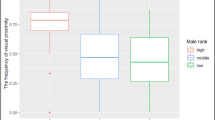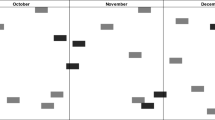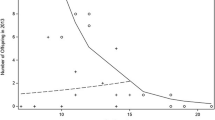Abstract
The mating behaviour and reproductive success of male Japanese macaques (Macaca fuscata) were studied in relation to the female sexual cycles, which were monitored from the plasma profiles of gonadotropins and ovarian hormones. Based on observations of the mating behaviour during four successive mating seasons and paternity identification by DNA fingerprinting in 35 out of 37 offspring born in the subsequent birth seasons, the correlations between (1) male dominance rank and timing of mating, and (2) male dominance rank and reproductive success were examined. The results may be summarized as follows. (1) The number of copulations with ejaculation by any male was positively correlated with the male dominance rank, but not with the identified numbers of offspring fathered by each male. (2) Males could not choose ovulatory females as mating partners: the number of copulations with ejaculation with females during ovulatory weeks was not related to the male's rank. Monopolized copulations in consortship were mostly observed between high-ranking males and non-lactating parous females after conception. (3) Paternity testing showed that the male copulating most frequently with a female was not the identified father in 11 out of 15 cases. Prediction of the fathers of offspring was difficult even from the number of copulations occurring at around the estimated time of ovulation. An adaptive explanation of these correlations is discussed.
Similar content being viewed by others
References
de Ruiter, J. R., W. Sheffrahn, G. J. J. M. Trommelen, A. G. Uitterlinden, R. B. Martin, &J. A. R. A. M. van Hooff, 1992. Male social rank and reproductive success in wild long-tailed macaques. In:Paternity in Primates: Genetic Tests and Theories,R. D. Martin,A. F. Dixson, &E. J. Wickings (eds.), Karger, Basel, pp. 173–191.
Hasegawa, T. &M. Hiraiwa-Hasegawa, 1983. Opportunistic and restrictive matings among wild chimpanzees in the Mahale mountains, Tanzania.J. Ethol., 1: 75–85.
Inoue, M., F. Mitsunaga, H. Ohsawa, A. Takenaka, Y. Sugiyama, A. G. Soumah, &O. Takenaka, 1991. Male mating behavior and paternity discrimination by DNA fingerprinting in a Japanese macaque group.Folia Primatol., 56: 202–210.
————, ————, ————, ————, ————, ————, & ————, 1992. Paternity discrimination by DNA fingerprinting and male mating behavior in an enclosed Japanese macaque group. In:Topics in Primatology,N. Itoigawa,Y. Sugiyama,G. P. Sackett, &K. R. Thompson (eds.), Univ. of Tokyo Press, Tokyo, pp. 35–45.
————,A. Takenaka, S. Tanaka, R. Kominami, &O. Takenaka, 1990. Paternity discrimination in a Japanese macaque troop by DNA fingerprinting.Primates, 31: 563–570.
———— &O. Takenaka, 1993. Japanese macaque microsatellite PCR primers for paternity testing.Primates, 34: 37–45.
Jeffreys, A. J., V. Wilson, &S. L. Thein, 1985. Hypervariable ‘minisatellite’ regions in human DNA.Nature, 314: 67–73.
Mitsunaga, F., M. Nozaki, M. Inoue, A. Takenaka, O. Takenaka, O. Sakura, Y. Sugiyama, &H. Ohsawa, 1992. Steroid hormones and sexual behavior of female Japanese monkeys in an enclosed group. In:Topics in Primatology,N. Itoigawa,Y. Sugiyama,G. P. Sackett, &K. R. Thompson (eds.), Univ. of Tokyo Press, Tokyo, pp. 23–34.
Nozaki, M., G. Watanabe, K. Taya, Y. Katakai, Y. Wada, I. Sasamoto, &K. Ohshima, 1990. Changes in circulating inhibin levels during pregnancy and early lactation in the Japanese monkey.Biol. Reprod., 43: 444–449.
————, ————, ————, ————, &S. Sasamoto, 1991. Changes in circulating inhibin levels during normal menstrual cycle in the Japanese monkey.Jpn. J. Anim. Reprod., 37: 97–103.
Okayasu, N., 1992. Prolonged estrus in female Japanese macaques (Macaca fuscata yakui) and the social influence on estrus: with special reference to male intertroop movement. In:Topics in Primatology,N. Itoigawa,Y. Sugiyama,G. P. Sackett, &K. R. Thompson (eds.), Univ. of Tokyo Press, Tokyo, pp. 163–178.
Paul, A. & J. Kuester, in press. Differential reproduction in male and female Barbary macaques (Macaca sylvanus). In:Evolutionary Ecology and Behaviour of the Macaques.J. E. Fa & D. G. Lindburg (eds.), Cambridge Univ. Press, Cambridge.
—, —,A. Timme, & J. Arnemann, 1993. The association between rank, mating effort and reproductive success in male Barbary macaques (Macaca sylvanus).Primates, 34: 000 - 000.
Perloe, S. I., 1992. Male mating competition, female choice and dominance in a free ranging group of Japanese macaques.Primates, 33: 289–304.
Smith, D. G., 1981. The association between rank and reproductive success of male rhesus monkeys.Amer. J. Primatol., 1: 83–90.
Sprague, D. S., 1992. Life history and male inter-troop mobility among Japanese macaques (Macaca fuscata).Int. J. Primatol., 13: 437–454.
Takasaki, H., 1985. Female life history and mating patterns among the M group chimpanzees of the Mahale National Park, Tanzania.Primates, 26: 121–129.
Wilson, M. E., T. P. Gordon, &D. C. Collins, 1982. Serum 17β-estradiol and progesterone associated with mating behavior during early pregnancy in female rhesus monkeys.Hormones Behav., 16: 94–106.
Author information
Authors and Affiliations
About this article
Cite this article
Inoue, M., Mitsunaga, F., Nozaki, M. et al. Male dominance rank and reproductive success in an enclosed group of Japanese macaques: with special reference to post-conception mating. Primates 34, 503–511 (1993). https://doi.org/10.1007/BF02382661
Received:
Accepted:
Issue Date:
DOI: https://doi.org/10.1007/BF02382661




